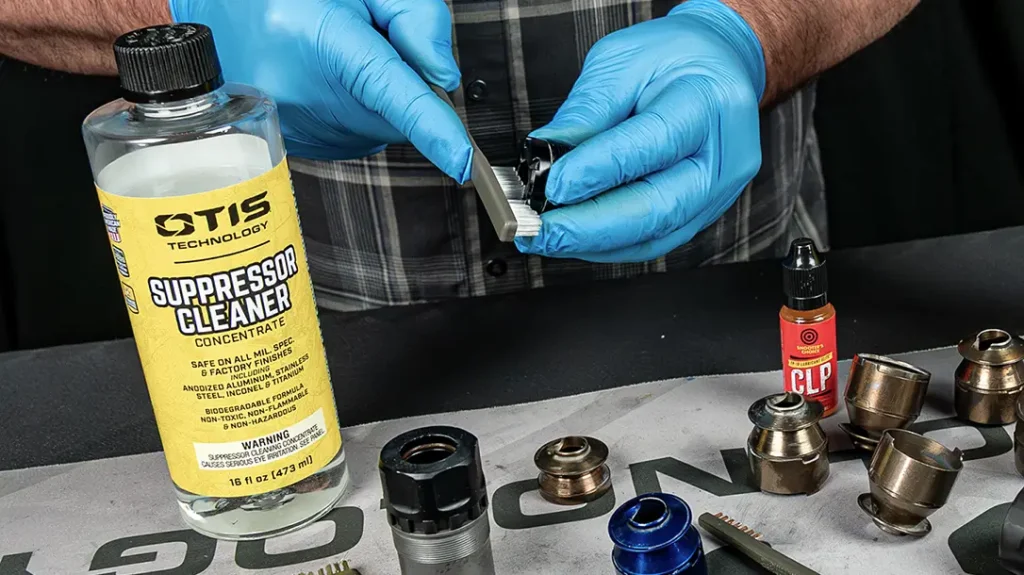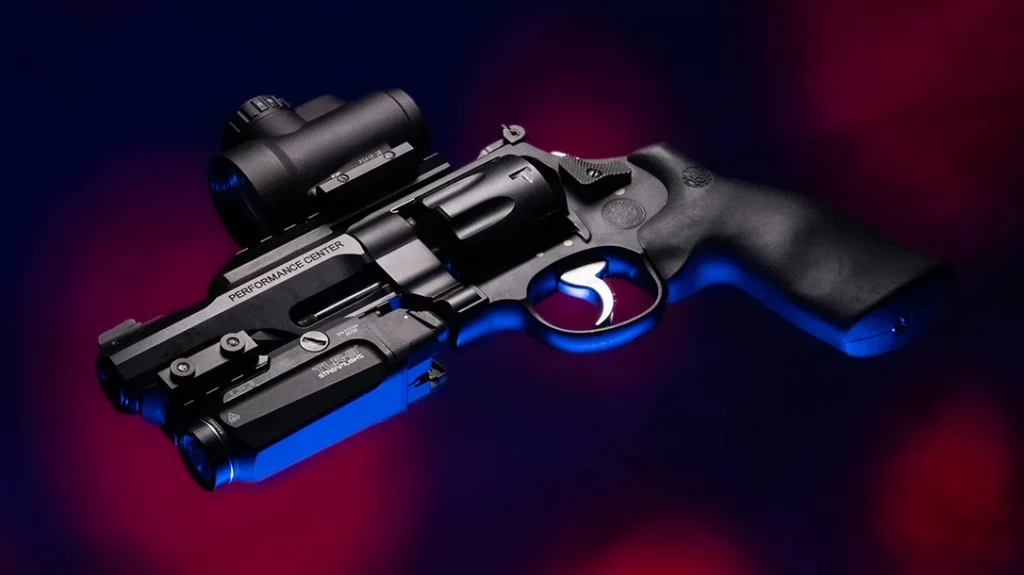Innovation is generally born from necessity, at least it’s supposed to be, but in today’s alternative, role-playing, zombie-apocalypse-influenced world, where seemingly anyone and everyone is “building” some form, fashion or color scheme of AR-15 or bolt-on rail-mounted accessory, it’s hard to tell what what’s passing for innovation. After all, we’re in an inexplicable era in which having any semblance of exposed rail space is more or less the eighth deadly sin, punishable by a lifetime loss of your man club card and permanent prohibition from bro-hugs, fist bumps, goatees and tribal tattoos. It’s difficult, if not impossible, to say what actually drives today’s so-called innovation, but it was not always this way. In fact, when our earliest family members crawled forth from the primordial ooze, they were heavily motivated by necessity when selecting one rock or club from another, because their very existence depended on finding tools that worked the best at dominating their opponents and keeping themselves from being eaten by the very creatures they were trying to bring home for dinner. Of course, there likely existed “innovative” and enterprising paleolithic knuckle-draggers who probably polished colored rocks, promising audiences that theirs were deadlier, higher-velocity sub-minute-of-angle rocks capable of outrageous terminal ballistics and trading them for more booty, and a few less attractive rocks.
Nevertheless, things in the old days were a little more practical, and in the centuries that passed, necessity was the prime driving force in the development of combative small arms, with results sometimes successful, sometimes disastrous.
Small Arms Breakthrough
Without question, the dominant weapon in the hands of the well-trained soldier is the rifle or carbine, and it has been for some time. This primary tool, known intimately to all of us who have served in uniform, has endured countless changes since its advent. We’ve witnessed an array of caliber changes, transitions from muzzleloaders to gas- and recoil-operated systems, and seen wood replaced by plastic, all in attempt to develop a more reliable, more accurate, lighter-weight weapon that’s durable long term, simple to maintain and even simpler to train with. By the late 1960s, NATO had universally adopted the lighter, smaller 5.56x45mm cartridge. Around the same time, the United States replaced the M14 and its larger .30-caliber round with the innovative, yet controversial M16, which, 40 years later, and after a great many modifications, remains the standard-issue infantry weapon for America’s armed forces.
Advertisement — Continue Reading Below
Another innovative small-arms development, one that’s not really new, is the frequently misunderstood and maligned bullpup carbine. A strange-looking gun, the bullpup is often regarded as something like a bad sci-fi prop gun put together by some B-level prop master: All its parts seem to be in the wrong places—at least per modern-day conventional wisdom. In reality, however, the bullpup offers very specific advantages over other weapons designs, making the format perfect for certain applications and certainly worth a solid, educated look. The bullpup’s most salient feature is its compactness; in fact, bullpups are sometimes as much as 25-percent shorter in terms of overall length than typical carbines while still featuring a full-length barrel, making no compromise in ammunition power and accuracy, yet allowing for better maneuverability in confined spaces. By general definition, a bullpup is a rifle whose barrel is seated farther back into the stock of the weapon and whose magazine is placed behind the trigger assembly. See, I told you: parts in all the wrong places. But how wrong is it really?
Along Came A Steyr
Championed by the British throughout the better part of the 20th century, several countries, including Belgium, Austria and France, have delved deeper into the development of this unique weapons platform, with many designs becoming standard-issue rifles for ground forces, police and special operations personnel. None made a significant impact on the United States—that is, until the Austrian arms manufacturer Steyr introduced the world to the Armee Universal Gewehr, or AUG. Finding service with the armed forces of over 20 countries and becoming the primary rifle of Austria and Australia, the AUG was, in the 1970s, a highly advanced weapon, combining in a single, standardized format the bullpup configuration, polymer housing, a vertical foregrip and an integrated optical sight. Extremely reliable, light and accurate, the Steyr AUG showed clearly the potential of the bullpup platform.
Advertisement — Continue Reading Below
At first glance, the AUG seems very futuristic, even a little bizarre, at least when compared side-by-side with more “conventional” weapons. But a closer look reveals a weapon with wicked efficiency and the handling characteristics of a high-performance sports car. From the AUG’s muzzle brake to the ergonomics of the buttplate, it’s not-so-painfully obvious that efficiency and human function were priorities in the AUG’s development. Unfortunately, even after being fielded by U.S. Customs and a handful of U.S. law enforcement agencies, the AUG fell victim to the 1989 importation ban, leaving it poorly represented in the U.S. and in extremely limited supply—until now.
Modular A3 SA
Steyr Arms, based in Trussville, Ala., has relaunched the AUG in a semi-automatic version for the U.S. market, the AUG/A3 SA. While the carbine’s basic design held true to the original AUG, Steyr made several enhancements, better orienting the A3 to the needs of today’s shooter, be he a professional, a sportsman or just an enthusiast. The adjustable gas-piston-operated AUG/A3 SA now has a bolt hold-open release lever, and the original factory-integrated optics housing has been replaced with fair quantity of top-mounted picatinny rail. There’s even a short, but ample strip of rail on the side of the A3 for mounting lights and other accessories.
Advertisement — Continue Reading Below
One of the most unique design features of the latest and greatest AUG is its modularity. The AUG/A3 has only six primary component groups; the barrel, receiver, bolt, stock, trigger and magazine. The center piece is the barrel group, which is comprised of a cold-hammer-forged, 16-inch, chrome-lined barrel with a 1-in-9-inch twist rate, a gas regulator assembly and a uniquely functional folding vertical foregrip. The entire unit is designed for toolless disassembly with a simple push of a button, which may not seem important until you realize that the AUG was designed to be much more than a singular tool. In fact, the AUG is a family of weapons, all based on the same platform, allowing one lone AUG to function in several different roles with available barrels in 16 inches, 20 inches, and 21.6 inches. In addition to being able to fulfill several roles, the highly modular AUG’s modularity is a fully ambidextrous weapon. The AUG can quickly be configured for use by left-handed shooters by simply exchanging the bolt with a left-handed version with the extractor and ejector on opposite sides and moving the left port cover from one side to the other.
I have two of the new AUG/A3 SAs and have been using them steadily since their arrival in early 2012. It’s important to note, when I say using I mean really using, not casually shooting, I personally train on average 1,200 law enforcement and military students a year across the country. When I got my AUGs they were immediately put to use—in some respects abused—and the pace has yet to slow. The AUGs arrived in soft cases with slings, cleaning kits and a fair quantity of both 30-round and 42-round magazines. While the AUG/A3 can be configured to run standard AR-15 magazines, I prefer the translucent polymer factory magazines. These European-designed magazines are hardy and make monitoring ammunition simple. They also tend to be more reliable than other mag designs—the Steyr magazines, for instance, are without doubt the toughest and most reliable I have ever used, never once having experienced a problem. Magazines lock into the Steyr as they do in other European-style weapons, including the AK-47—that is, by way of a spring-loaded latch, which reduces side-to-side movement of the magazine. Unlike their European counterparts, Steyr magazines aren’t locked in front first; rather, they’re slid into the magazine well and locked into place. AUG magazines are nearly as fast to unload and reload as AR mags, while sacrificing none of the reliability characteristic of European magazine designs.
AUG In Training
Advertisement — Continue Reading Below
Getting accustomed to the ergonomics of the AUG took little time, and I settled into it quickly. Thanks to the design’s intrinsic weight displacement, which makes the gun seem much lighter than it in fact is, I found the bullpup easy and stress-free to carry shouldered for long periods of time. The AUG/A3 is pretty simple and straightforward to operate: insert a magazine, charge the weapon by way of the non-reciprocating cocking handle, deactivate the easily accessed and very positive safety, and you’re up and running. Because I tend to train students to use weapons in somewhat austere conditions and in unconventional positions, I like to set my training tools up for different applications and leave them that way. On one of the AUG/A3s I affixed a Vortex SPARC red-dot sight and a set of XS Sights XTI offset sights; on the other I mounted a larger and heavier Aimpoint CompM3. I took both AUGs to two classes I was scheduled to teach to several local SWAT teams, giving me plenty of opportunities to put the bullpups through their paces and then some. And because I was going to have to demonstrate drills and techniques, I was keeping my fingers crossed that things went off without a hitch.
The very first shots with the AUG/A3 were off the bench and were done using a variety of .223 ammunition: Hornady 75-grain Boat Tail HP TAP, Winchester 45-grain Jacketed Hollow Point and a hodge-podge of old military 55-grain full metal jacket. Shooting groups at 100 yards proved that the AUG/A3 was capable of digesting anything and making some remarkable things happen on paper. In fact, my worst group, shot with a mix of ammunition and my aged, deteriorating eyesight, measured less than 2 inches. This, in spite of the AUG/A3’s relatively heavy trigger pull (9 pounds plus or minus).
Typically in a bullpup design, the trigger takes a hit because of the added length of the trigger linkage creates notoriously heavy, sometimes awkward trigger pulls. The AUG/A3’s trigger was surprisingly smooth and crisp, and while it weighed about 9 pounds, it felt much lighter.
Advertisement — Continue Reading Below
Following the bench shooting, I spent the rest of the range time burning up the remaining ammunition on more practical courses of fire, under a wide variety of conditions and from several awkward and unconventional positions. At one point, I ran a cover drill that required maintaining a good cadence while alternating positions on the cover, from standing to prone and back. The AUG’s excellent ergonomics and handling characteristics make using and manipulating it in every position, even from seated in the cramped confines of a small car, simple and smooth. In fact, during the entirely of the range work, with more than 1,000 rounds fired, I didn’t experience a single malfunction of any kind.
Nearly 150 years old, Steyr is an established company, one with a well-earned reputation for quality and craftsmanship. In bringing back the AUG, they have done a fantastic job maintaining the original bullpup’s design features, while making several useful enhancements.
For more information, visit steyrarms.com or call 205-655-8299.
























